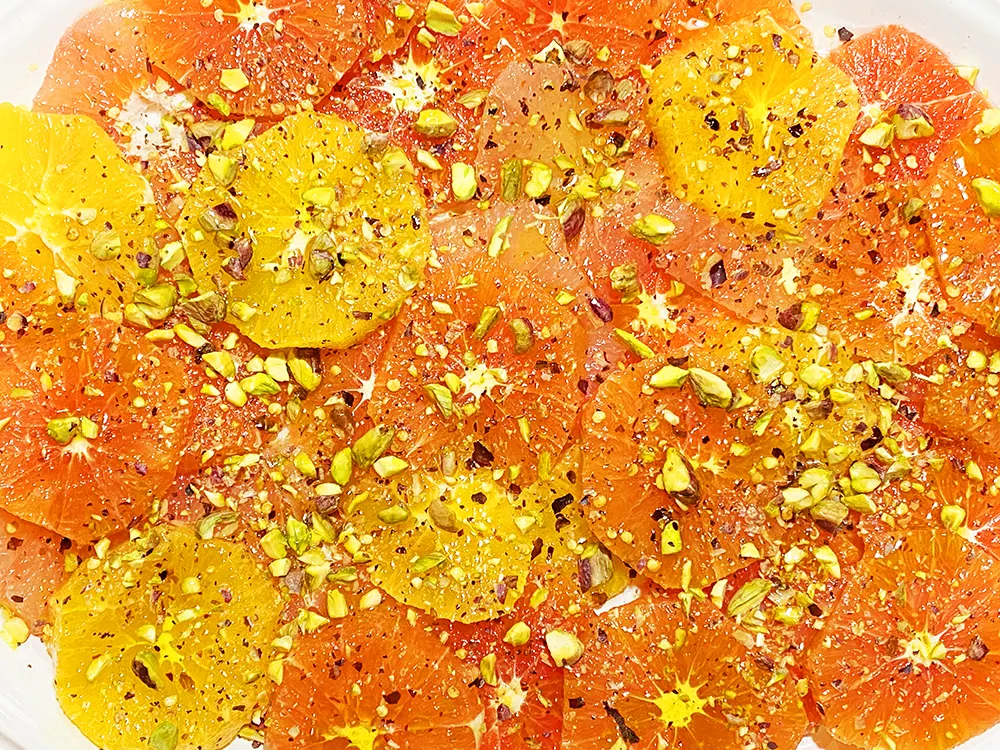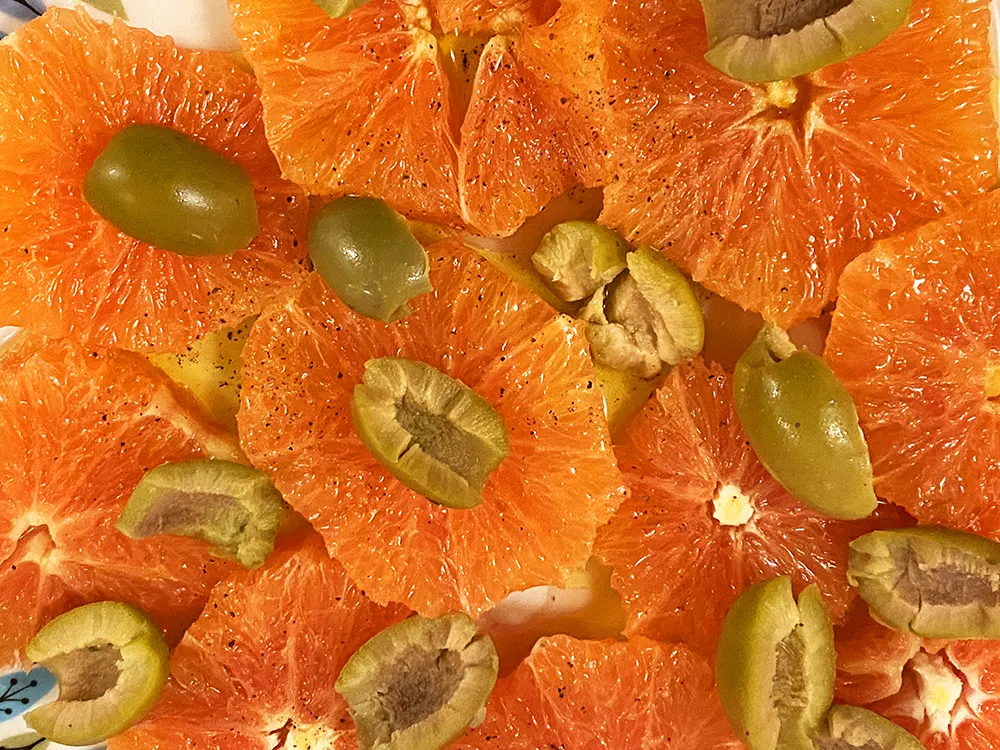How Sicilian Citrus Salad Conquered the World (Or At Least The Internet)
By Ian MacAllen on Friday, April 19th, 2024 at 2:48 pm | 6,069 views

Just about everyone seems to have a recipe for Sicilian-style citrus salad these days. The colorful combination of oranges photographs beautifully, particularly since the fruits span a spectrum of deep red to pale yellow, from blood oranges to grapefruits. In the era of visual-forward social media like TikTok and Instagram, brightly colored foods get the clicks.
Sitrus salad, insalada di Agrumi in Italian, isn’t new. But it is suddenly very popular in American cuisine appearing not only social media but in printed recipes. The dish may contain a diverse set of ingredients. The most basic version is simply sliced oranges topped with olive oil, salt and black or crushed red pepper. Another traditional variation combines fennel and citrus with an assortment of other savory ingredients like red onion, olives, pistachios, or almonds. Ideally, several varieties of citrus are combined to balance bitter and sweet flavors.
There are two common ways for cutting the oranges. They can be supremed, a technique where the peel is removed and each piece of fruit is cut individually from the membrane holding the fruit together. More commonly– probably because its an easier knife technique– the peel and pith are cut away and the remaining fruit is sliced into medallions. These slices are then laid flat on a serving platter and additional ingredients added to the top.
Now for the savory ingredients. There are quite a few different recipes circulating. In true Italian fashion, citrus salad is a dish that can come together using the ingredients on hand. Vegetables like fennel and red onion should be sliced thinly. Olives, whether green or brown or cured, should be pitted and cut or pulled apart. Black pepper, crushed red pepper, and salt are added to taste, as are herbs like thyme or mint.

The flavor combination’s invention is largely attributed to the era of Spanish rule over Sicily. Spain also has a strong tradition of using citrus in savory salads, and similar recipes known as Spanish citrus salad have had less internet fame but are equally historic. Sicilian salads are more likely to see ingredients from the island and south of Italy incorporated, like crushed pistachios or even Italian cheeses, but the flavors are similar. The regions have similar growing conditions, and a shared culinary history.
Citrus salad is also seen in Arab cuisines of north Africa, and the dish may have entered into Sicilian and Spanish cooking during the periods of time when the Arab empires ruled the respective nations. Recipes with ground cinnamon may indicate a particular recipe has more of an Arab influence, or pomegranate seeds. The term Moroccan citrus salad actually entered into the American lexicon forty or fifty years ago, with Sicilian citrus salad, essentially the same dish, becoming more prevalent today. A resurgence in Italian American culture, and a recent fixation on southern Italy in film, television, and books may explain why Sicily is culturally more interesting than Morocco — but that’s a different essay.
The citrus fruits originate in Asia and the fruit arrived in Italy during the Roman Empire, likely by way of the Silk Road trading routes. By the 3rd century, Citron, a type of sour citrus, were cultivated in Italy. These lemon-like fruits have a thick pith layer and small fruity interior, and were primarily an export used for perfumes.
Oranges first arrived in Sicily through Arab trade routes, perhaps as early as the 7th century. The connection is evident in the Italian term for orange, arancia, drawing on the Arab “nāranj.” Bitter oranges similar to the modern melàngolo arrived with Portuguese sailors. These oranges were hybrids developed from pomelos and tangerines, cultivated before they were introduced to Europeans.
After close to a millennia of growing imported varieties, a natural mutation in Sicily created a blood orange. The Moro variety is deep rich, blood red and was discovered around Siracusa and thought to have evolved naturally in the 19th century. The red color develops in the oranges when night temperatures grow cool. Another variety, the Sanguinello, was discovered in Spain in the 1920s, but has become a large export crop in Sicily.
Another variant that developed in Italy is known as the Tarocco, and it is thought to have mutated from the Sanguinello. Tarocco oranges are “half-blood” oranges, and not as dark as the moro. They are the most common variety of orange in Italy, and the term itself can mean a fraud.

Sicilian citrus salads became very trendy in the last several years, but it wasn’t always that way. The idea of citrus salad in American cuisine often meant canned fruits in syrup mixed with cottage cheese, like in a 1948 ad for Iris Fine Foods that suggested combining the contents of the can with cheese, and serving it with French dressing. Other citrus salads of the era involved jello molds or canned mandarin oranges with marshmallows, like with cloyingly sweet Ambrosia salad.
By the 1980s at least, Americans were more focused on fresh citrus. Partly this influence can be attributed to shifts in food culture that happened in California with people like Alice Waters introducing farm-to-table as the ideal. Fruits like avocados were being introduced to Americans, and so they too were added to citrus.
Americans were beginning to be more adventurous with flavors too, and that meant experimenting with nonwestern cuisines and spices. What we now call Sicilian salad was often termed Moroccan citrus salad, like this Craig Claiborne recipe in the New York Times, revived in 2010. It’s quite similar to what is now passing around as a Sicilian salad today, but made exotic through the lens of western empire.
Salad trends have had significant evolution through the years. Caroline E. Mayer, writing in the Washington Post in 1994, points out that in the 1970s, curried salads, fruits and nuts were popular, but by the 1980s it was goat cheese. She was setting up an argument that the 1990s would be the era of grilled chicken salad. Salads follow trends. Watermelon salads in the 2000s, and kales salads in the 2010s. But the 2020s will likely be known as the era of the citrus salad.
The last few years have seen recipes from places like Saveur, and the New York Times, or a second one from the same writer at the New York Times, or this one from Bon Appetit (admittedly, from 2002), or Food and Wine that serve as a portent to the sudden interest in these recipes. But the citrus salad was ripe for the era of TikTok.
Instagram has a handful of images specifically tagged as #SicilianCitrusSalad, but well over 11,000 using the more basic hashtag #citrussalad. Arguably, the bigger influence in the last several years has been TikTok, the video sharing app that has earned the ire of Congress. But like Instagram, TikTok has similar large number of videos tagged #SicilianCitrusSalad representing a much smaller collection of videos than #citrussalad. Clearly, though, citrus is a popular item on both platforms.

ring spice to the table.
While there are plenty of earlier examples, 2023 seems to be a year where the citrus salad really hit its stride on TikTok. Internet personality and cookbook author Carolina Gelen posted this video with close to 300,000 views early in the year, with numerous other variations following. She of course is by no means the only person showing off colorful orange and blood orange salads, but she surfaces to the top of the popular tab.
2023 was also a big year for Sicilian cookbooks. In September, Fabrizia Lanza’s The Food of Sicily offers a recipe with citrus, fennel, black olives and anchovies. In Katie Parla’s Food of the Italian Islands, from the spring 2023, she describes fennel and citrus as having become a cliché. It doesn’t prevent her from offering her own recipe, where she omits fennel.
The rise of the citrus salad in the age of TikTok makes sense. It’s the same reason so many successful, trendy restaurants have dishes that look stunning on camera. Citrus salads are visually appealing with shades of bright orange and rich red fruits contrasted with green fennel, pistachios, and dark olives. The flavors are easy to enjoy, especially in the winter months when freshness is hard to come by. Whether you call it a Moroccan salad, Spanish salad, or Sicilian salad, mixing in fresh citrus with savory flavors is a delicious sweet and savory dish.
How to Make Your Own
Finding a nice balance between sweet oranges and sour citrus is important. Grapefruits and blood oranges tend to be more bitter, while cara cara oranges and navel oranges are more sweet.
How to cut your oranges:
Begin by slicing off the peel and pith. Leave as much fruit as possible while removing all of the white membrane. At this point you can either supreme the fruit, creating wedges, or slice the fruit into medallions. Larger fruits like grapefruits or pomelos are easier to supreme. Also you can mix and match medallions and wedges.
Below are a number of variations on the recipe. All of these ingredients can be combined in different ways to your own unique taste. More sour fruits like grapefruits can be added, or the dishes can be made entirely with sweeter varieties like cara cara oranges. Any type of olive can be used as well (though we always recommend removing the pits).
Recipes:
Basic Version
Ingredients
2 sweet oranges (cara cara, navel)
2 bitter oranges (blood oranges)
Black pepper
Crushed red pepper
Instructions
Lay sliced oranges on a serving platter
Sprinkle with olive oil, black pepper, crushed red pepper
Pistachio and Red onion
Ingredients
2 sweet oranges (cara cara, navel)
2 bitter oranges (blood oranges)
2 shallots or 1 red onion
½ cup crushed pistachios
½ cup green olives
Black pepper
Instructions
Lay sliced oranges on a serving platter
Dice the shallots or onion finely and sprinkle over the oranges
Cut the olives in half
Sprinkle with olive oil, black pepper, sliced olives, and crush pistachios
Fennel, Anchovy, and Olive
Ingredients
2 sweet oranges (cara cara, navel)
2 bitter oranges (blood oranges)
1 Fennel Bulb
1 cup cured olives
6 oil anchovies
Instructions
Supreme the oranges
Squeeze the juice from the remaining pulp
Remove the hard center of the fennel
Slice the fennel into slivers
Cut the olives in half
Mix in the anchovies
Toss with olive oil and juice from the oranges

